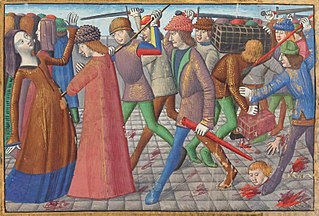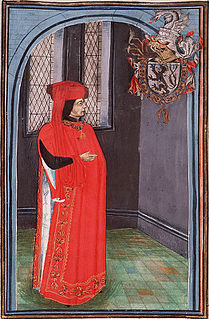
John the Fearless was Duke of Burgundy as John I from 1404 until his death. A scion of the royal house of France, he played an important role in French affairs during the early 15th century, in particular the struggles to rule the country for the mentally ill King Charles VI and the Hundred Years' War with England. His rash, unscrupulous, and violent political dealings contributed to the eruption of the Armagnac–Burgundian Civil War in France, and culminated in his assassination in 1419.

Saint-Jacques Tower is a monument located in the 4th arrondissement of Paris, France, on Rue de Rivoli at Rue Nicolas Flamel. This 52-metre (171 ft) Flamboyant Gothic tower is all that remains of the former 16th-century Church of Saint-Jacques-de-la-Boucherie, which was demolished in 1797, during the French Revolution, leaving only the tower. What remains of the destroyed church of St. Jacques La Boucherie is now considered a national historic landmark. The closest métro station is Châtelet.

Isabella of Bourbon, Countess of Charolais was the second wife of Charles the Bold, Count of Charolais and future Duke of Burgundy. She was a daughter of Charles I, Duke of Bourbon and Agnes of Burgundy, and the mother of Mary of Burgundy, heiress of Burgundy.
Simon Lecoustellier, called Caboche, a skinner of the Paris Boucherie, played an important part in the Cabochien Revolt of 1413. He had relations with John the Fearless, Duke of Burgundy, since 1411, and was prominent in the seditious disturbances which broke out in April and May, following on the Etats of February 1413. In April, he stirred the people to the point of revolt and was among the first to enter the hotel of the Dauphin. When the butchers had made themselves masters of Paris, Caboche became bailiff and warden of the Charenton-le-Pont. Upon the publication of the great ordinance of May 26, he used all his efforts to prevent conciliation between the Burgundians and the Armagnacs. After the fall of the Cabochien party on 4 August, he fled to Burgundy in order to escape from royal justice. Doubtless he returned to Paris in 1418 with the Burgundians.

The Cabochien revolt was an episode in the civil war between the Armagnacs and the Burgundians which was in turn a part of the Hundred Years' War.
The écorcheurs were armed bands who desolated France in the reign of Charles VII, stripping their victims of everything, often to their very clothes.
The Burgundian party was a political allegiance against France that formed during the latter half of the Hundred Years' War. The term "Burgundians" refers to the supporters of the Duke of Burgundy, John the Fearless, that formed after the assassination of Louis I, Duke of Orléans. Their opposition to the Armagnac party, the supporters of Charles, Duke of Orléans, led to a civil war.
The League of the Public Weal was an alliance of feudal nobles organized in 1465 in defiance of the centralized authority of King Louis XI of France. It was masterminded by Charles the Bold, Count of Charolais, son of the Duke of Burgundy, with the king's brother Charles, Duke of Berry, as a figurehead.

John II of Luxembourg, Count of Ligny was a French nobleman and soldier, a younger son of John of Luxembourg, Lord of Beauvoir, and Marguerite of Enghien. His older brother Peter received his mother's fiefs, including the County of Brienne, while John received Beaurevoir. He married Jeanne de Béthune, Viscountess of Meaux, widow of Robert of Bar, on 23 November 1418, and became step-father to Jeanne de Bar, Countess of Marle and Soissons. He and Jeanne de Béthune had no children.

Louis was the eighth of twelve children of King Charles VI of France and Isabeau of Bavaria. He was their third son and the second to hold the titles Dauphin of Viennois and Duke of Guyenne, inheriting them in 1401, at the death of his older brother, Charles (1392–1401).

The Armagnac–Burgundian Civil War was a conflict between two cadet branches of the French royal family — the House of Orléans and the House of Burgundy from 1407 to 1435. It began during a lull in the Hundred Years' War against the English and overlapped with the Western Schism of the papacy.

John the Fearless, Duke of Burgundy, was assassinated on the bridge at Montereau on 10 September 1419 during a parley with the French dauphin, by Tanneguy du Chastel and Jean Louvet, the dauphin's close counsellors.
The dual monarchy of England and France existed during the latter phase of the Hundred Years' War when Charles VII of France and Henry VI of England disputed the succession to the throne of France. It commenced on 21 October 1422 upon the death of King Charles VI of France, who had signed the Treaty of Troyes which gave the French crown to his son-in-law Henry V of England and Henry's heirs. It excluded King Charles's son, the Dauphin Charles, who by right of primogeniture was the heir to the Kingdom of France. Although the Treaty was ratified by the Estates-General of France, the act was a contravention of the French law of succession which decreed that the French crown could not be alienated. Henry VI, son of Henry V, became king of both England and France and was recognized only by the English and Burgundians until 1435 as King Henry II of France. He was crowned King of France on 16 December 1431.

The porte Saint-Antoine was one of the gates of Paris. There were two gates named the porte Saint-Antoine, both now demolished, of which the best known was that guarded by the Bastille, on the site now occupied by the start of Rue de la Bastille in the 4th arrondissement of Paris.

The Tour Jean-sans-Peur or Tour de Jean sans Peur, located in the 2nd arrondissement of Paris, is the last vestige of the Hôtel de Bourgogne, the residence first of the Counts of Artois and then the Dukes of Burgundy. The tower contained bed chambers and the grand stairway of the original residence, which stood next to it. It was completed between 1409–1411 by Jean sans Peur. The original hôtel occupied about a hectare of land, the boundaries of which are now marked by the rues Étienne Marcel, Montorgueil, Saint-Sauveur, and Saint-Denis. The tower itself is located at 20 rue Étienne Marcel, in the courtyard of an elementary school. It is one of the best surviving examples of medieval residential architecture in Paris. The tower is open to the public and presents changing expositions on life in the Middle Ages.

In the 10th century, Paris was a provincial cathedral city of little political or economic significance, but under the kings of the Capetian dynasty who ruled France between 987 and 1328, it developed into an important commercial and religious center and the seat of the royal administration of the country. The Île de la Cité became the site of the royal palace and the new cathedral of Notre-Dame, begun in 1163. The Left Bank was occupied by important monasteries, including the Abbey of Saint-Germain-des-Prés and the Abbey of St Genevieve. In the late 1100s, the collection of colleges on the left bank became one of the leading universities in Europe. The Right Bank, where the ports, central markets, artisans and merchants were located, became the commercial center of the city, and the merchants assumed an important role in running the city. Paris became a center for the creation of illuminated manuscripts and the birthplace of Gothic architecture. Despite civil wars, the plague, and foreign occupation, Paris became the most populous city in the Western world during the Middle Ages.

The siege of Paris was an assault undertaken in September 1429 during the Hundred Years' War by the troops of the recently crowned King Charles VII of France, with the notable presence of Joan of Arc, to take the city held by the English and their Burgundian partisans. King Charles's French troops failed to enter Paris, defended by the governor Jean de Villiers de L'Isle-Adam and the provost Simon Morhier, with the support of much of the city's population.
The siege of Saint-Denis was the last instance of cooperation between the English and their Burgundian allies in the Hundred Years' War. Saint-Denis, the traditional burial place of the kings of France, was located in the outskirts of English-held Paris, and had been captured by the French a couple of months earlier. The enemy presence there critically endangered the English position in the capital, and, aiming to retake it urgently, the English moved onto the town in August with a handful of Burgundian auxiliaries. The siege was undertaken during the peace congress of Arras, during which no end to the fighting was seen, as both sides struggled to gain ground around and over Paris. The English were victorious at St. Denis after the French garrison surrendered due to lack of external support.
Events from the year 1413 in France.













